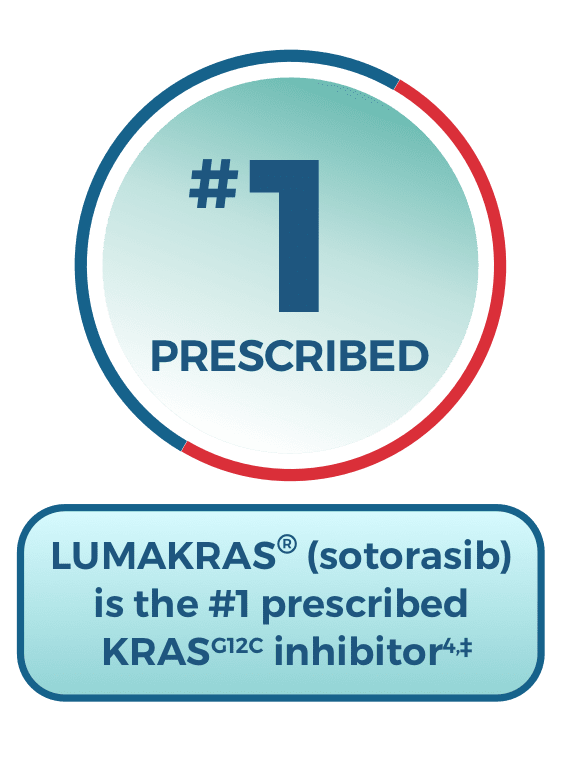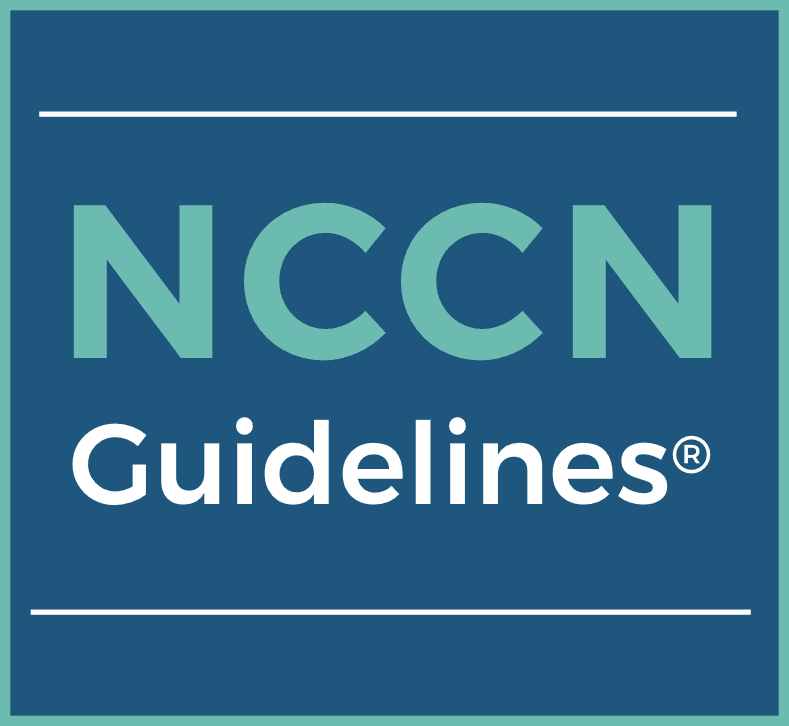IMPORTANT SAFETY INFORMATION
Hepatotoxicity
- LUMAKRAS can cause hepatotoxicity, which may lead to drug-induced liver injury and hepatitis.
- Among 357 patients who received LUMAKRAS in CodeBreaK 100, hepatotoxicity occurred in 1.7% (all grades) and 1.4% (Grade 3). A total of 18% of patients who received LUMAKRAS had increased alanine aminotransferase (ALT)/increased aspartate aminotransferase (AST); 6% were Grade 3 and 0.6% were Grade 4. In addition to dose interruption or reduction, 5% of patients received corticosteroids for the treatment of hepatotoxicity.
- Monitor liver function tests (ALT, AST, and total bilirubin) prior to the start of LUMAKRAS, every 3 weeks for the first 3 months of treatment, then once a month or as clinically indicated, with more frequent testing in patients who develop transaminase and/or bilirubin elevations.
- Withhold, dose reduce or permanently discontinue LUMAKRAS based on severity of adverse reaction.
Interstitial Lung Disease (ILD)/Pneumonitis
- LUMAKRAS can cause ILD/pneumonitis that can be fatal. Among 357 patients who received LUMAKRAS in CodeBreaK 100 ILD/pneumonitis occurred in 0.8% of patients, all cases were Grade 3 or 4 at onset, and 1 case was fatal. LUMAKRAS was discontinued due to ILD/pneumonitis in 0.6% of patients.
- Monitor patients for new or worsening pulmonary symptoms indicative of ILD/pneumonitis (e.g., dyspnea, cough, fever). Immediately withhold LUMAKRAS in patients with suspected ILD/pneumonitis and permanently discontinue LUMAKRAS if no other potential causes of ILD/pneumonitis are identified.
Most common adverse reactions
- The most common adverse reactions ≥ 20% were diarrhea, musculoskeletal pain, nausea, fatigue, hepatotoxicity, and cough.
Drug interactions
- Advise patients to inform their healthcare provider of all concomitant medications, including prescription medicines, over‑the‑counter drugs, vitamins, dietary and herbal products.
- Inform patients to avoid proton pump inhibitors and H2 receptor antagonists while taking LUMAKRAS.
- If coadministration with an acid-reducing agent cannot be avoided, inform patients to take LUMAKRAS 4 hours before or 10 hours after a locally acting antacid.
INDICATION
LUMAKRAS is indicated for the treatment of adult patients with KRAS G12C‑mutated locally advanced or metastatic non‑small cell lung cancer (NSCLC), as determined by an FDA‑approved test, who have received at least one prior systemic therapy.
This indication is approved under accelerated approval based on overall response rate (ORR) and duration of response (DOR). Continued approval for this indication may be contingent upon verification and description of clinical benefit in a confirmatory trial(s).
Please see full LUMAKRAS Prescribing Information.
IMPORTANT SAFETY INFORMATION
Hepatotoxicity
- LUMAKRAS® can cause hepatotoxicity and increased ALT or AST which may lead to drug-induced liver injury and hepatitis.
- In the pooled safety population of NSCLC patients who received single agent LUMAKRAS® 960 mg hepatotoxicity occurred in 27% of patients, of which 16% were Grade ≥ 3. Among patients with hepatotoxicity who required dosage modifications, 64% required treatment with corticosteroids.
- In this pooled safety population of NSCLC patients who received single agent LUMAKRAS® 960 mg, 17% of patients who received LUMAKRAS® had increased alanine aminotransferase (ALT)/increased aspartate aminotransferase (AST); of which 9% were Grade ≥ 3. The median time to first onset of increased ALT/AST was 6.3 weeks (range: 0.4 to 42). Increased ALT/AST leading to dose interruption or reduction occurred in 9% of patients treated with LUMAKRAS®. LUMAKRAS® was permanently discontinued due to increased ALT/AST in 2.7% of patients. Drug-induced liver injury occurred in 1.6% (all grades) including 1.3% (Grade ≥ 3).
- In this pooled safety population of NSCLC patients who received single agent LUMAKRAS® 960 mg, a total of 40% patients with recent (≤ 3 months) immunotherapy prior to starting LUMAKRAS® had an event of hepatotoxicity. An event of hepatotoxicity was observed in 18% of patients who started LUMAKRAS® more than 3 months after last dose of immunotherapy and in 17% of those who never received immunotherapy. Regardless of time from prior immunotherapy, 94% of hepatotoxicity events improved or resolved with dosage modification of LUMAKRAS®, with or without corticosteroid treatment.
- Monitor liver function tests (ALT, AST, alkaline phosphatase, and total bilirubin) prior to the start of LUMAKRAS®, every 3 weeks for the first 3 months of treatment, then once a month or as clinically indicated, with more frequent testing in patients who develop transaminase and/or bilirubin elevations. Withhold, reduce the dose or permanently discontinue LUMAKRAS® based on severity of the adverse reaction. Consider administering systemic corticosteroids for the management of hepatotoxicity.
Interstitial Lung Disease (ILD)/Pneumonitis
- LUMAKRAS® can cause ILD/pneumonitis that can be fatal.
- In the pooled safety population of NSCLC patients who received single agent LUMAKRAS® 960 mg ILD/pneumonitis occurred in 2.2% of patients, of which 1.1% were Grade ≥ 3, and 1 case was fatal. The median time to first onset for ILD/pneumonitis was 8.6 weeks (range: 2.1 to 36.7 weeks). LUMAKRAS® was permanently discontinued due to ILD/pneumonitis in 1.3% of LUMAKRAS®-treated patients. Monitor patients for new or worsening pulmonary symptoms indicative of ILD/pneumonitis (e.g., dyspnea, cough, fever). Immediately withhold LUMAKRAS® in patients with suspected ILD/pneumonitis and permanently discontinue LUMAKRAS® if no other potential causes of ILD/pneumonitis are identified.
Most Common Adverse Reactions
- The most common adverse reactions ≥ 20% were diarrhea, musculoskeletal pain, nausea, fatigue, hepatotoxicity, and cough.
Drug Interactions
- Advise patients to inform their healthcare provider of all concomitant medications, including prescription medicines, over‑the‑counter drugs, vitamins, dietary and herbal products.
- Inform patients to avoid proton pump inhibitors and H2 receptor antagonists while taking LUMAKRAS®.
- If coadministration with an acid-reducing agent cannot be avoided, inform patients to take LUMAKRAS® 4 hours before or 10 hours after a locally acting antacid.
INDICATION
LUMAKRAS® is indicated for the treatment of adult patients with KRAS G12C‑mutated locally advanced or metastatic non‑small cell lung cancer (NSCLC), as determined by an FDA‑approved test, who have received at least one prior systemic therapy.
This indication is approved under accelerated approval based on overall response rate (ORR) and duration of response (DOR). Continued approval for this indication may be contingent upon verification and description of clinical benefit in a confirmatory trial(s).
Please see full LUMAKRAS® Prescribing Information.
IMPORTANT SAFETY INFORMATION
Hepatotoxicity
- LUMAKRAS® can cause hepatotoxicity and increased ALT or AST which may lead to drug-induced liver injury and hepatitis.
- In the pooled safety population of NSCLC patients who received single agent LUMAKRAS® 960 mg hepatotoxicity occurred in 27% of patients, of which 16% were Grade ≥ 3. Among patients
with hepatotoxicity who required dosage modifications, 64% required treatment with corticosteroids.
- In this pooled safety population of NSCLC patients who received single agent LUMAKRAS® 960 mg, 17% of patients who received LUMAKRAS® had increased alanine aminotransferase (ALT)/increased aspartate aminotransferase (AST); of which 9% were Grade ≥ 3. The median time to first onset of increased ALT/AST was 6.3 weeks (range: 0.4 to 42). Increased ALT/AST leading to
dose interruption or reduction occurred in 9% of patients treated with LUMAKRAS®. LUMAKRAS® was permanently discontinued due to increased ALT/AST in 2.7% of patients. Drug-induced
liver injury occurred in 1.6% (all grades) including 1.3% (Grade ≥ 3).
- In this pooled safety population of NSCLC patients who received single agent LUMAKRAS® 960 mg, a total of 40% patients with recent (≤ 3 months) immunotherapy prior to starting
LUMAKRAS® had an event of hepatotoxicity. An event of hepatotoxicity was observed in 18% of patients who started LUMAKRAS® more than 3 months after last dose of immunotherapy and in
17% of those who never received immunotherapy. Regardless of time from prior immunotherapy, 94% of hepatotoxicity events improved or resolved with dosage modification of LUMAKRAS®,
with or without corticosteroid treatment.
- Monitor liver function tests (ALT, AST, alkaline phosphatase, and total bilirubin) prior to the start of LUMAKRAS®, every 3 weeks for the first 3 months of treatment, then once a month or as
clinically indicated, with more frequent testing in patients who develop transaminase and/or bilirubin elevations. Withhold, reduce the dose or permanently discontinue LUMAKRAS® based on
severity of the adverse reaction. Consider administering systemic corticosteroids for the management of hepatotoxicity.
Interstitial Lung Disease (ILD)/Pneumonitis
- LUMAKRAS® can cause ILD/pneumonitis that can be fatal.
- In the pooled safety population of NSCLC patients who received single agent LUMAKRAS® 960 mg ILD/pneumonitis occurred in 2.2% of patients, of which 1.1% were Grade ≥ 3, and 1 case was
fatal. The median time to first onset for ILD/pneumonitis was 8.6 weeks (range: 2.1 to 36.7 weeks). LUMAKRAS® was permanently discontinued due to ILD/pneumonitis in 1.3% of
LUMAKRAS®-treated patients. Monitor patients for new or worsening pulmonary symptoms indicative of ILD/pneumonitis (e.g., dyspnea, cough, fever). Immediately withhold LUMAKRAS® in
patients with suspected ILD/pneumonitis and permanently discontinue LUMAKRAS® if no other potential causes of ILD/pneumonitis are identified.
Most Common Adverse Reactions
- The most common adverse reactions ≥ 20% were diarrhea, musculoskeletal pain, nausea, fatigue, hepatotoxicity, and cough.
Drug Interactions
- Advise patients to inform their healthcare provider of all concomitant medications, including prescription medicines, over‑the‑counter drugs, vitamins, dietary and herbal products.
- Inform patients to avoid proton pump inhibitors and H2 receptor antagonists while taking LUMAKRAS®.
- If coadministration with an acid-reducing agent cannot be avoided, inform patients to take LUMAKRAS® 4 hours before or 10 hours after a locally acting antacid.
INDICATION
LUMAKRAS® is indicated for the treatment of adult patients with KRAS G12C‑mutated locally advanced or metastatic non‑small cell lung cancer (NSCLC), as determined by an FDA‑approved test, who have received at least one prior systemic therapy.
This indication is approved under accelerated approval based on overall response rate (ORR) and duration of response (DOR). Continued approval for this indication may be contingent upon verification and description of clinical benefit in a confirmatory trial(s).
Please see full LUMAKRAS® Prescribing Information.






